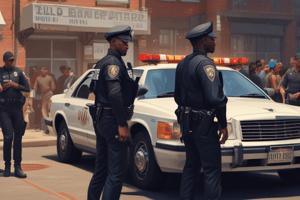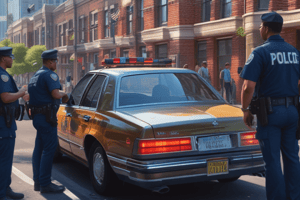Podcast
Questions and Answers
Which of the following best describes 'Bureaucracy' in the context of police organization?
Which of the following best describes 'Bureaucracy' in the context of police organization?
- A rigid structure that prevents innovation within the police department.
- An informal network of officers who share information and resources unofficially.
- A system where each officer operates independently, making decisions based on personal judgment.
- A hierarchically structured administrative organization designed to carry out specific functions. (correct)
Which of the following is an example of an officer-initiated activity?
Which of the following is an example of an officer-initiated activity?
- Providing first aid to a car accident victim.
- Questioning citizens during traffic stops. (correct)
- Responding to a call about a domestic disturbance.
- Completing paperwork at the end of a shift.
How do clearance rates provide insight into police effectiveness?
How do clearance rates provide insight into police effectiveness?
- By showing the total number of crimes committed, regardless of arrests.
- By tracking the amount of time taken to solve cold cases.
- By comparing the number of crimes reported to the media versus the number of arrests made.
- By comparing crimes committed to arrests made, indicating the proportion of cases solved. (correct)
What is the primary function of forensic science in criminal investigations?
What is the primary function of forensic science in criminal investigations?
Why did the collection of Alonzo King's DNA spark legal debate?
Why did the collection of Alonzo King's DNA spark legal debate?
What is the main goal of directed patrol strategy?
What is the main goal of directed patrol strategy?
The Broken Windows Theory suggests that:
The Broken Windows Theory suggests that:
What is the primary goal of community policing?
What is the primary goal of community policing?
What is a key difference between 'burnout' and 'PTSD' in the context of police mental health?
What is a key difference between 'burnout' and 'PTSD' in the context of police mental health?
What does 'qualified immunity' protect police officers from?
What does 'qualified immunity' protect police officers from?
Flashcards
Police Discretion
Police Discretion
The power of police officers to make choices on how to act in different situations.
Bureaucracy (in policing)
Bureaucracy (in policing)
A hierarchically structured administrative organization that carries out specific functions, characterized by a chain of command and delegation of authority.
Patrol Duties
Patrol Duties
Maintaining police visibility, public order, and providing non-crime services.
Confidential Informant (CI)
Confidential Informant (CI)
Signup and view all the flashcards
Forensics
Forensics
Signup and view all the flashcards
Hot Spots
Hot Spots
Signup and view all the flashcards
Reactive Arrests
Reactive Arrests
Signup and view all the flashcards
Broken Windows Theory
Broken Windows Theory
Signup and view all the flashcards
Problem-Oriented Policing
Problem-Oriented Policing
Signup and view all the flashcards
Burnout
Burnout
Signup and view all the flashcards
Study Notes
The Role of Discretion in Policing
- Police discretion is justified by the trust placed in officers.
- Officers' experience, training, and knowledge of human/criminal behavior are factors of discretion.
- Allows officers to make reasonable, protective decisions.
Factors and Elements of Police Discretion
- Elements include the nature/seriousness of the crime, wrongdoer attitude, victim/offender relationship, and departmental policy.
- Policy provides the guiding principles.
Police Organization and Field Operations
- Bureaucracy provides a hierarchically structured administrative organization for specific functions.
- Police departments have a chain of command.
- Delegation of authority involves taking orders and being responsible to a supervisor.
- Cities are divided into zones, beats, or precincts, often with eight- or twelve-hour shifts for personnel.
- Law enforcement occurs in the field through patrol, investigations, and special investigations.
- Patrol is the backbone of policing
Patrol Objectives
- Deterrence of crime. and increased police visibility
- Maintaining public order and a sense of security.
- Provision of non-crime services 24/7.
Patrol Activities
- Patrol aims to maintains presence in the community.
- Officers respond to calls for service.
- Administrative duties, such as report writing, are performed.
- Officers may initiate activities like questioning citizens during traffic stops.
Detective Investigations
- Detectives are the primary police investigators of crimes.
- Undercover operations are sometimes used.
- Confidential informants (CIs) involved in criminal activity may provide information to the police in exchange for something.
- Clearance rates compare committed crimes and arrests.
- Cold cases are investigations that remain unsolved for an extended time.
Forensic Investigations and DNA
- Forensics applies science to establish facts and gather evidence.
- Crime scene forensics are important
- Trace evidence includes fingerprints, blood, hair, and fibers.
- Ballistics is the study of firearms, bullets, and their trajectory.
- Fingerprint analysis relies comparison to find similarity.
- Fingerprint analysis is reliable, but not without the possibility of human error.
DNA
- DNA is a genetic blueprint unique to each individual (except identical twins).
- Scientists compare thirteen points ("markers") on DNA fingerprints to match DNA.
- A positive DNA fingerprint match has a probability as high as 30 billion to one.
DNA Collection Policies
- These policies vary by state.
- Convicted felony offenders are legally required to provide a DNA sample.
- The FBI's CODIS contains 4 million DNA profiles of arrestees.
- NJ has code for DNA Collection
Maryland v. King (2013)
- Alonzo King was arrested for threatening with a shotgun, leading to his DNA being taken.
- His DNA matched evidence from an unsolved rape case, resulting in his conviction and life sentence.
- He challenged the DNA collection as an unreasonable invasion of rights.
- The Supreme Court ruled that collecting DNA from individuals arrested for serious crimes is a reasonable search under the Fourth Amendment, emphasizing DNA collection’s importance in law enforcement.
Concerns About DNA Collection
- Concerns exist about the potential for misuse of genetic information and privacy invasion.
- Opinions on the constitutionality and the reasonableness of the invasion of rights vary.
Incident-Driven Policing
- Incident-driven policing means one-third of patrol time is spent answering citizen calls.
- Response time refers to the time between a call and police arrival.
- Prioritizing calls intends to improves response time efficiency.
911 Technology and Patrol Strategies
- Computer-aided dispatch (CAD) involves a 911 operator entering crime information which prioritizes responses.
- Random patrol involves officers monitoring a general area to detect crimes in progress or deter crime.
- Directed patrol involves targeting a specific area to prevent a specific type of crime and is more efficient than random patrols.
Smart Policing and Crime Mapping
- Smart policing utilizes hot spot technology where high criminal activity areas draw directed patrol
- Crime mapping uses analysts to identify trends and patterns in crime.
- CompStat started in mid-1990s in New York City that deployed computerized crime mapping.
Arrest Strategies
- Reactive arrests are made in response to a call for service or a crime in progress.
- Proactive arrests result from police activity targeting a particular crime.
- The broken windows theory suggests that addressing visible signs of disrepair can reduce crime.
- Some experts question the broken windows theory because of dropping violent crime rates.
- "Zero tolerance" policies are criticized as discriminatory.
Community Policing and Problem-Oriented Policing
- Community policing emphasizes community support and cooperation to deter and solve crime.
- Police form personal relationships with residents and partnerships with local leaders.
- This is a collaborative reform effort.
- Problem-oriented policing means identifying criminal activity and responding to its underlying causes.
Physical Dangers of Police Work
- In 2020, 175 officers were killed in the line of duty from assault or accident.
- From 2018 to 2020, 113 officers were killed in traffic-related incidents where 43% weren't wearing seat belts.
- 116 officers were killed from gunfire in 2018-2020.
Mental Health of Police Work
- Stressors for police include the constant fear of violence, exposure to crime, need to comply with the law, lack of community support, and negative media coverage.
- Consequences of police stress are burnout and PTSD.
- Burnout is mental exhaustion.
- PTSD involves re-experiencing traumatic events, survival guilt, and withdrawing from normal social interactions.
- Most officers mask their emotional trauma due to subculture norms.
Police Use of Force
- Physical force is used in about 1% of 53.5 million police interactions.
- Nondeadly force is not likely to cause death or serious injury.
- Reasonable force is what a reasonable person would assume necessary to carry out legal duties
- Deadly force is likely to cause death or serious injury.
Use of Force Reform
- Washington, D.C. requires police use of force to be objectively (or factually) reasonable, not subjective.
- Washington, D.C. and New York banned chokeholds.
- The Attorney General of NJ released a policy on use of force in 2022.
- Priorities are high-speed pursuits and de-escalation tactics
Police Misconduct and Ethics
- Professionalism involves adhering to a set of values that show a police officer to be of high moral character.
- Types of corruption include bribery, shakedowns, and mooching.
- Bribery involves officers accepting money for favors.
- Shakedowns involve officers coercing money.
- Mooching involves officers accepting gifts.
- Officers justify corrupt actions under the ends justify the means mentality
Police Accountability Measures
- Internal disciplinary measures are in place.
- Self-accountability means that officers are responsible for their own actions.
- Supervisory accountability entails advising and disciplining officers.
- Administrative accountability entails that department policies promote accountability.
- An internal affairs unit (IA) investigates misconduct allegations.
- Self-surveillance where officers wear camera systems.
- Citizens may have oversight through reviewing police complaints.
Police Liability
- Officers can face charges for unreasonable use of force, including aggravated assault and murder.
- Lawsuits can be filed against officers, departments, or cities for officers' unreasonable actions.
- Qualified immunity protects officers from civil liability if they did not violate constitutional rights.
Issues of Bias in Policing
- Blacks are 3.6 times more likely to have force used against them.
- Blacks are 50% more likely to be exposed to nonlethal force.
- Blacks and Latinos are three times more likely to be searched during a traffic stop.
- Police departments collect data and report inter-departmental use of force incidents.
- The FBI conducts national use of force data.
Studying That Suits You
Use AI to generate personalized quizzes and flashcards to suit your learning preferences.




